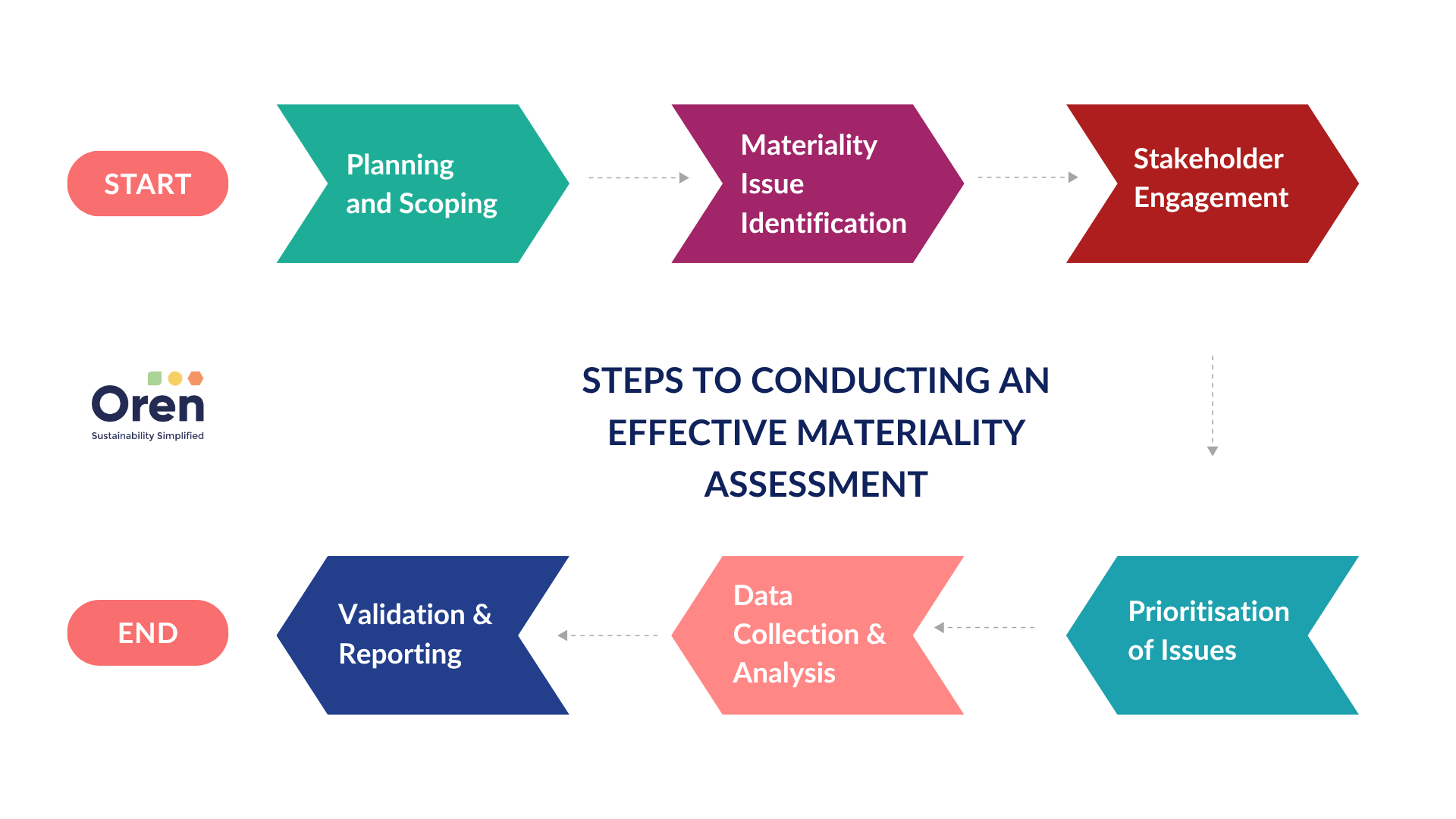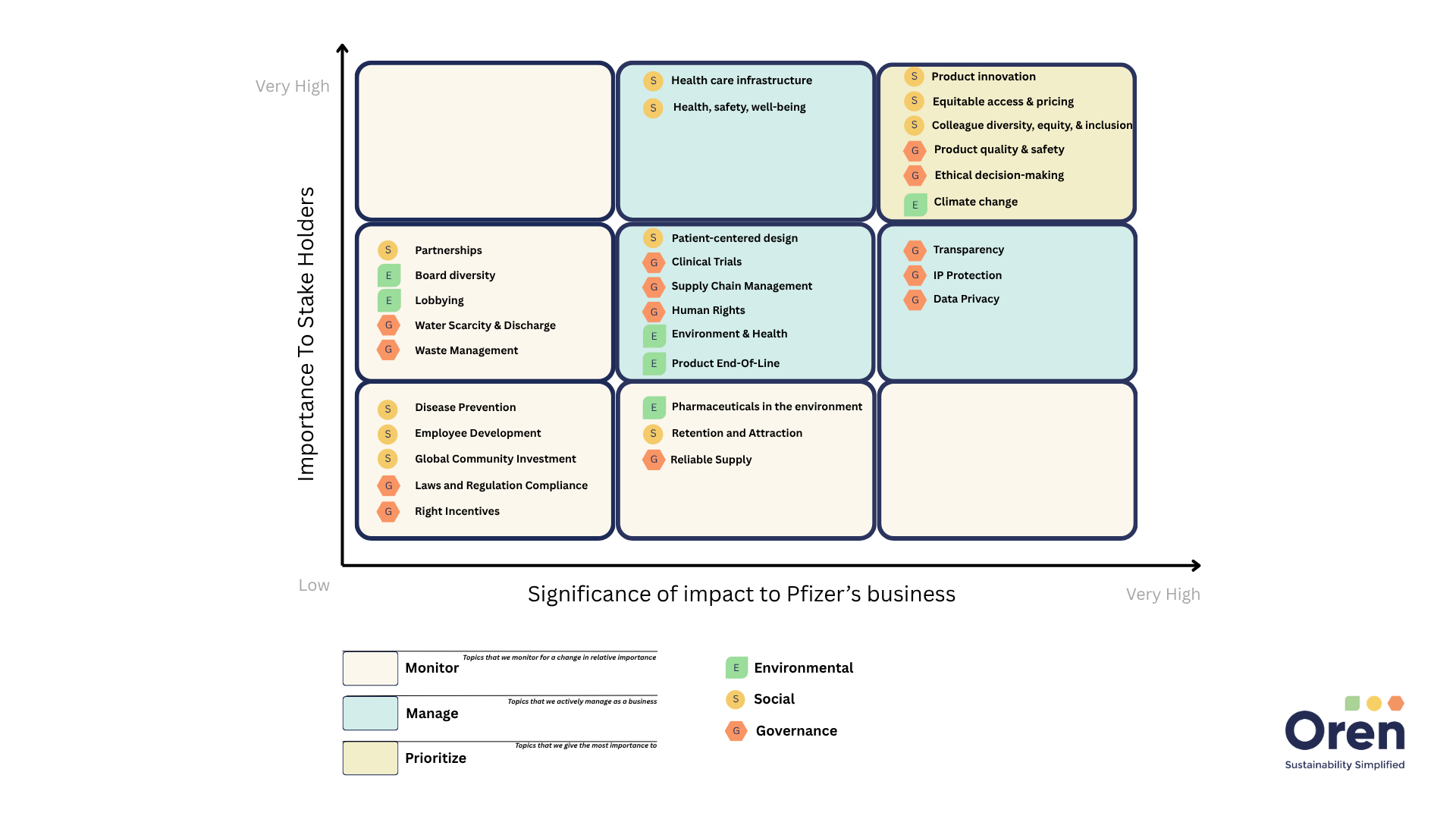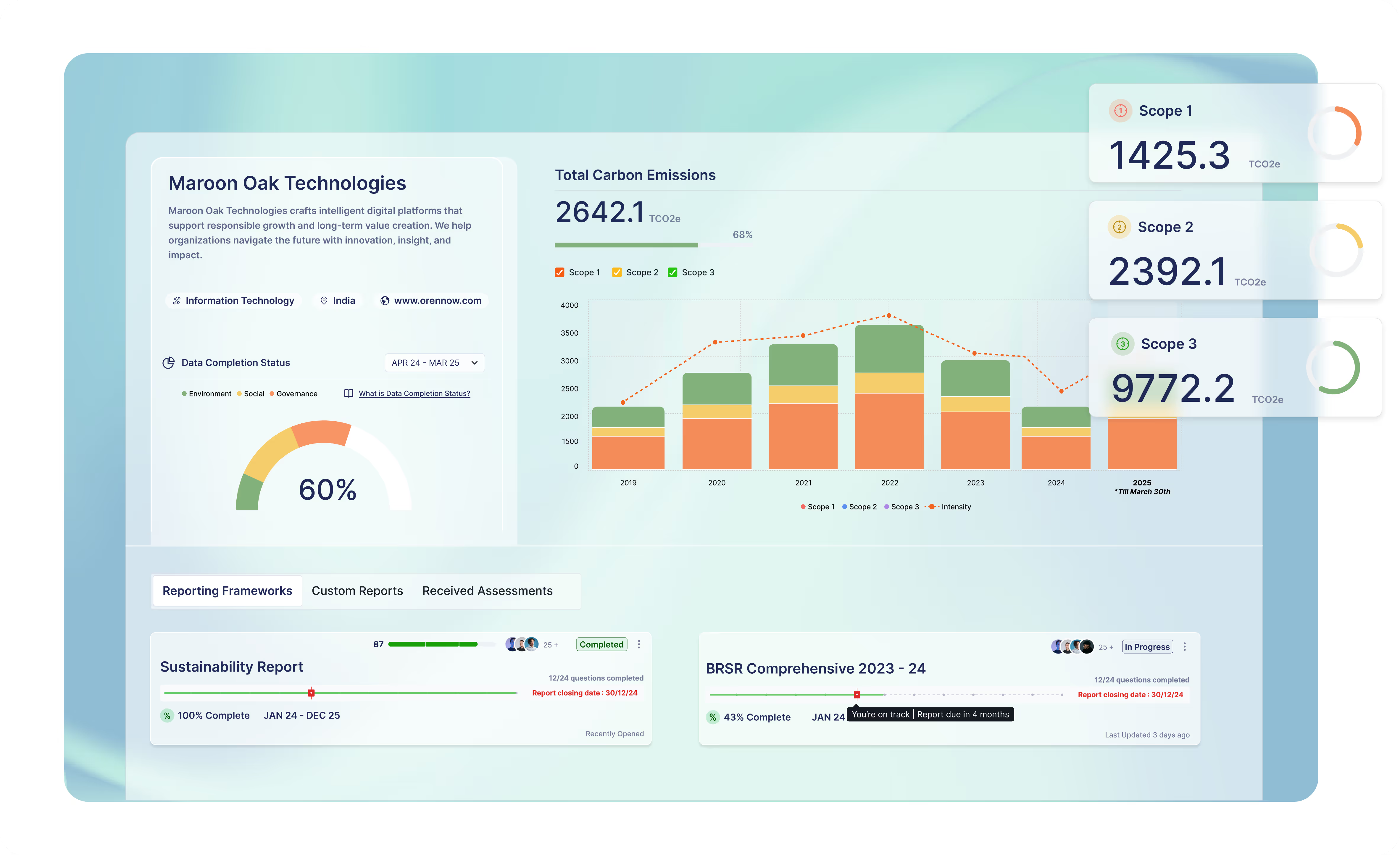Sustainability Simplified: Understanding Materiality Assessment
.webp)
What is a Materiality Assessment?
A materiality assessment is a strategic tool that is used by companies to identify and prioritise Environmental, Social, and Governance (ESG) issues that are most significant to both their operations and stakeholders. This process involves evaluating the relevance and impact of various ESG factors or topics within the company-specific context. Then seeking feedback from all internal and external stakeholders of how they prioritise these ESG factors or topics and then finally ranking these ESF factors or topics by importance to stakeholders and importance to business which is represented through a materiality matrix.
Materiality assessments are generally conducted at a frequency of 3 to 5 years. The frequency of conducting a materiality assessment varies as per the industry dynamics, regulatory changes, and stakeholder demands. Companies can also consider redoing the materiality assessment after mergers or acquisitions. The regular review ensures that companies remain responsive to evolving ESG challenges and opportunities while keeping their ESG strategies relevant. Companies can also utilise a sustainability materiality assessment template to structure and standardise this process efficiently.
Importance of Materiality Assessment in ESG Reporting
Companies can conduct a materiality assessment to help figure out which ESG factors are most important for the success of their business and the interests of their stakeholders. Adding this assessment to your sustainability reporting plan is important for meeting the needs of different internal and external stakeholder groups such as:
- Investors
- Customers
- Regulators
- Banks
- Consumers
- Employees
- Top Management
- Shareholders through the Board of Directors
This evaluation helps you in the following aspects:
- To determine which ESG topics, such as carbon emissions or water management or waste management or supply chain sustainability or employee health and safety, etc., are relevant to your business
- To improve and align your ESG strategy with the ESG topics that are important to your business and stakeholders
- To promote more transparency with stakeholders
- To help you fully comply with the requirements of reporting standards like GRI (Global Reporting Initiative) and BRSR (Business Responsibility and Sustainability Reporting)
Materiality assessment is important for complying with sustainability regulations like the U.S. Securities and Exchange Commission (SEC) and the EU’s Corporate Sustainability Reporting Directive (CSRD). While both frameworks aim to improve the quality and accessibility of ESG disclosures, they differ significantly in their treatment of materiality in ESG.
Stakeholders Involved in a Materiality Assessment
Effective materiality assessments involve a broad spectrum of stakeholders to capture diverse perspectives:
- Internal Stakeholders: It includes employees at various levels and covering all departments, management teams, and sustainability departments. Even the opinion of the company’s board of directors is considered in the materiality assessment.
- External Stakeholders: It includes customers, investors, bankers, suppliers, industry associations, NGOs, and local communities.
Balancing these perspectives allows companies’ reports to reflect material concerns from both financial and societal aspects.
Method of Stakeholder Engagement
Engaging stakeholders efficiently ensures their views are fully considered and that the right people participate. Here is what to focus on:
1. Stakeholder Ranking
Engaging stakeholders provides a comprehensive view of the ESG issues that are most pertinent to both the organisation and its wider community. But there are certain scenarios witnessing a variety of views and issues from different stakeholders. An efficient method of handling it is ranking the stakeholders as high, medium, or low against specific criteria.
2. Continuous Participation
The stakeholder engagement must be throughout the process. The early and continued discussions help to identify the most relevant ESG topics while also considering or handling the emerging issues, such as business environments and regulatory landscapes. Companies should also establish clarity on who should be involved at various stages and when. For instance, the board of directors must be part of the discussion focused on priority setting, while employees should be part of the risk identification discussion.
3. Interaction Techniques
Another essential aspect to focus on in ensuring time and cost-efficient stakeholder engagement. It can be further achieved by utilising the existing information, such as surveys or interviews, deriving key details from regular or daily interactions, developing a questionnaire for external stakeholders for any concerns, or other such methods.
Key Trends Shaping Materiality and ESG Reporting
ESG materiality is evolving and making major changes owing to the growing climate risks, consumer pressures, investor prioritisation, and regulatory efforts. Here are the insights into key trends that are shaping materiality and ESG reporting:
Adoption of Double Materiality
Regulators in the EU, through CSRD, are driving the adoption of double materiality. It requires companies to report both financial and impact materiality.
- The financial materiality focuses on the impact of ESG issues on the company’s financial performance and position. The companies must disclose the impact of sustainability aspects on their business. The reports are utilised by financial stakeholders and investors.
- The impact materiality emphasises the companies’ operations’ impact on society and the environment. It includes the impact on the community, employees, and other such groups.
Rising Investor Scrutiny
Investors increasingly use ESG assessments to estimate long-term financial viability from ESG factors like climate readiness and resilience planning. Institutional and retail investors are also actively engaging with companies to monitor and improve ESG performance, increasing the importance of transparency on material ESG topics. Companies failing to meet investor expectations risk reputational damage and reduced access to capital.
Digital Tools and Technology
Organisations are adopting digital solutions to streamline materiality assessments. Automated surveys, ESG data management platforms such as Oren Sustainability Hub, and dashboards allow for faster identification of priority ESG issues. It also helps centralise the data. Moreover, organisations can improve reporting accuracy and support informed stakeholder engagement. Digital tools also help integrate ESG insights into daily operations and long-term planning and also keep an eye on how industry peers are viewing and evolving their material ESG topics and ESG strategy in general. .
Alignment with Global Standards
Companies are aligning reporting with frameworks such as GRI, SASB, and TCFD. The coming together of disclosures with international standards:
- Enhances compatibility
- Satisfies investor expectations
- Ensures compliance across jurisdictions
It also helps integrate ESG strategies into broader business continuity and climate action plans. Thus, it supports long-term operational resilience.

Steps to Conducting an Effective Materiality Assessment
1. Planning and Scoping
Assemble a Project Team: Form a team with representatives from different departments and stakeholder groups. Companies can also utilise external sustainability consultants for support on this activity.
Define Objectives and Scope: Set clear goals for the materiality assessment and outline the scope, taking into account industry best practices and relevant regulations.
2. Materiality Issue Identification
Compile ESG Issues: Create a comprehensive list of potential ESG issues relevant to your company’s operations and industry. This should include internal data, stakeholder feedback, and sustainability best practices. Companies can also do this by conducting a peer benchmarking exercise and determine what ESG topics their peers (who are more mature from a sustainability standpoint) are reporting on. Companies can also review guidance from reporting standards such as SASB, GRI, etc. to determine these topics.
3. Stakeholder Engagement
Identify and Engage Stakeholders: Develop a strategy to interact with key stakeholders through surveys, interviews, workshops, and online platforms. Companies then need to determine which are the stakeholder groups that are relevant to their business and which stakeholders from each group will they engage. For example, if they do not have any investors, we don’t need to include that stakeolder group in this exercise. If the company does business with other enterprises, then they can pick their top 5-10 customers to engage for this exercise.
Gather Feedback: Collect insights on the ESG issues that are most important to stakeholders and your organisation.
4. Prioritisation of Issues
Use a Prioritisation Matrix: Evaluate the significance of each ESG issue using a matrix that considers:
- The potential effect of the issue on financial, environmental, and social performance of the company.
- The relevance of the issue to all stakeholders.
5. Data Collection and Analysis
Gather Supporting Data: Collect data from internal sources (e.g., sustainability reports, life cycle assessments) and external sources (e.g., feedback collected from all stakerholders engaged, industry benchmarks, academic research) to substantiate the prioritisation process.
6. Validation and Reporting
- Validate Findings: Confirm the results with stakeholders and finalise the materiality matrix, which visually represents the prioritised ESG issues.
- Prepare a Comprehensive Report: Document the assessment process, key findings, and an actionable roadmap for integrating materiality considerations into your sustainability strategy.
Example: Pfizer’s Materiality Assessment
An example of an effective materiality assessment is Pfizer’s approach to identifying ESG issues.
Pfizer engaged with a range of internal and external stakeholders, including employees, investors, policymakers, and patient advocacy groups. This thorough engagement helped them identify and prioritise ESG issues that are critical to their sustainability strategy.

Best Practices for Enhancing Materiality Assessment
Materiality assessment can be streamlined and improved in the following ways:
1. Broader Stakeholder Engagement
Engaging a wide range of stakeholders, such as investors, customers, employees, suppliers, regulators, and local communities, allows for the gain of insights into diverse perspectives. It can be achieved through surveys, workshops, interviews, or focus group discussions. But before that, set goals and objectives and identify and categorise the stakeholders. Further, incorporating these insights ensures that the assessment captures issues that are both financially and socially significant, making the outcomes more relevant and actionable.
2. Regular Reviews and Updates
Conduct regular reviews and update the assessment to ensure alignment with current and responsive emerging trends. This proactive approach enables companies to anticipate potential risks and opportunities rather than reacting after issues arise.
3. Integration with Business Strategy
Align the materiality assessments with the overall organisational strategy for an impact. It helps sustainability initiatives to contribute to long-term value creation. Further, the benefit is also seen in the effective allocation of resources towards the most critical areas, ensuring actions are purposeful rather than isolated.
4. Alignment with Reporting Frameworks
Aligning the assessment with established reporting standards provides consistency in reporting. It also enhances compatibility with peers and helps meet the expectations of investors and stakeholders.
5. Documentation and Transparency
Thorough record management of stakeholder inputs, methodologies, and decisions is crucial. Transparent documentation demonstrates accountability and allows stakeholders to understand the process behind materiality decisions.
Top Advantages of Materiality Assessment
The key advantages of conducting a materiality assessment are as follows:
1. Focus on relevant ESG priorities
They help businesses identify which environmental, social, and governance issues are most significant to their operations and stakeholders. This ensures that resources and efforts are directed towards areas that have the greatest impact rather than wasting resources on less relevant topics.
2. Improved reporting credibility
The structured assessment helps companies enhance the accuracy and reliability of their ESG reporting. Stakeholders can also trust that the shared information reflects genuine business priorities and rigorous analysis rather than generic statements.
3. Enhances communication strategies
The identification of the key ESG issues relevant for each stakeholder group can help improve communications. It helps generate targeted updates and reports, while the dedication also increases stakeholder engagement.
4. Strong stakeholder trust
Materiality assessments demonstrate transparency and accountability, building confidence among customers, investors, employees, and communities. It also makes stakeholders more likely to engage with and support companies that proactively address issues that actually make an impact.
5. Enhanced strategic decision-making
Insights from these assessments guide leadership position holders in aligning sustainability initiatives with business goals. It enables more informed and impactful decision-making.
6. Proactive addressing of long-term risks
ESG issues like future regulatory changes or climate resilience can significantly impact businesses in the future. Materiality assessment helps rank them according to their importance and potential impact. This allows organisations to take a proactive approach rather than reacting when issues arise.
Challenges of a Materiality Assessment
There also exist certain challenges in materiality assessment, which include:
1. Identifying truly material issues
It is complex because it demands balancing financial performance with societal and environmental impact. The challenges include corporate bias, conflicting stakeholder expectations, and the vast scope of value chains. Without a clear definition and process, companies risk focusing only on convenient or strategically aligned issues, overlooking truly material ones.
2. Ensuring diverse stakeholder input
The balanced and credible assessment from diverse stakeholders requires investment of time, resources, and careful coordination. Poor representation of the stakeholders' point of view develops blind spots in ESG priorities. The lack of inclusive engagement also leads to the risk of overlooking critical concerns, reduced trust, and poor overall effectiveness of the assessment.
3. Adapting to a changing ESG landscape
The constant evolution of ESG priorities with new regulations, societal expectations, and market risks also adds to the challenges. It is due to the requirement to meet the new compliance standards, be agile in meeting the responses of the public and investors, and reassess and improve overall risk management frameworks.
Double Materiality vs. Single Materiality
Single Materiality looks at ESG issues that have a big effect on how well the company does financially or operationally. Double Materiality, on the other hand, looks at how the company's actions affect the environment and society, as well as how these effects affect the company's long-term success. This means that it works from both the outside in (financial materiality) and the inside out (impact materiality). Using a double materiality approach gives a fuller picture of sustainability.
Current Situation and Future Trends
The adoption of double materiality has been uneven globally. In the US, Generally Accepted Accounting Principles (GAAP) and most regulatory frameworks still stress single materiality. Companies that report under GRI are, however, moving more and more toward an approach based on a wider range of effects. The EU has been encouraging the integration of double materiality from 2024 onward through CSRD and EU Taxonomy.
Globally, ISSB has not yet embedded double materiality in its standards. But rising stakeholder pressure and market demand are likely to accelerate its inclusion. This signals a future trend of greater global convergence, with double materiality becoming a central principle of sustainability reporting.
Why Should Your Company Conduct a Materiality Assessment?
A materiality assessment is necessary for an enterprise. It highlights the relevant environmental, social, and governance priorities, supports informed decision-making, enables compliance with evolving regulations, and strengthens stakeholder trust through transparent engagement. By aligning sustainability priorities with business goals, companies can create long-term value and competitiveness. The key benefits include:
1. Strategic clarity
Validates whether the company’s strategy effectively addresses environmental and social priorities.
2. Risk anticipation
Identifies long-term ESG risks and prepares proactive responses.
3. Stakeholder alignment
Ensures diverse stakeholder perspectives are integrated into business planning.
4. Regulatory compliance
Prepares enterprises for evolving reporting standards such as CSRD and EU taxonomy.
5. Competitive edge
Highlights opportunities in sustainability trends, clean energy, and shifting market demands.
6. Prioritisation
Establishes a hierarchy of critical ESG issues, preventing oversight of key topics.
7. Business value
Demonstrates relevance in a society transitioning to sustainable practices.
Road Ahead for ESG Materiality Assessments
The future of ESG materiality assessments is moving beyond compliance checklists and toward deeper integration with strategy and innovation. Digital tools such as AI, big data, and real-time analytics are streamlining stakeholder engagement and enabling dynamic tracking of ESG priorities. Global standards, including CSRD in the EU and the ISSB framework, are driving greater consistency and compatibility across markets.
At the same time, the focus is shifting from disclosure to measuring real-world impact on climate, biodiversity, and communities. Enterprises will increasingly need to demonstrate not only how ESG issues affect them but also how their operations shape society and the environment.
Conclusion
A materiality assessment is an important part of managing sustainability well. It helps in making sure a business is successful in the long run. The process also helps companies better meet the needs of their stakeholders and make real progress in their environmental and social performance. Adding these assessments to your business plan makes sure that companies stay strong, flexible, and emerge competitive.
Frequently Asked Questions
Is a Materiality Assessment Mandatory for Companies?
Materiality assessment is not mandatory for companies across the world. However, multiple jurisdictions, like those in India, Europe UK etc., require companies to disclose ESG-related information. Conducting an assessment helps organisations identify and prioritise critical ESG issues, ensure compliance with reporting regulations, and meet stakeholder expectations. Even Section A of the BRSR (Business Responsibility and Sustainability Report) requires companies to disclose their material issues and whether they view it as a risk or an opportunity.
How Does a Materiality Assessment Differ from Double Materiality?
The materiality assessment, or single materiality, deals with the financial impact of ESG issues on a company’s operations and value for investors. The double materiality deals with both financial and impact materiality. It looks at how external factors impact the company and how the company’s actions and operations affect the broader climate, environment, and society.
What Is a Materiality Matrix and How Is It Used?
A materiality matrix is a visual graph to plot the ESG issues axes: the x-axis represents importance to the business, and the y-axis represents importance to stakeholders. It helps companies prioritise key ESG topics, align strategies with stakeholder expectations, and guide reporting and decision-making.
Does My Company Need to Conduct a Materiality Assessment?
An ESG materiality assessment is essential for companies because it provides strategic clarity, validates sustainability priorities, anticipates long-term risks, and ensures stakeholder alignment. Before creating a sustainability report in any format, a company must conduct a mteriality assessment as it supports compliance with reporting standards, identifies opportunities in sustainability and clean energy, and helps in informed decision-making.
Why Is Conducting an ESG Materiality Assessment Important?
Conducting an ESG materiality assessment helps companies identify ESG issues, improve business performance, enhance communication with stakeholders, prioritise actions, comply with regulations, and improve risk management.
Latest Blog Posts
Dive into our blog for insights on making your organization more sustainable.
Sustainability Simplified
Wherever you are in your sustainability journey, we help you advance with confidence.
Schedule a Call



.avif)

